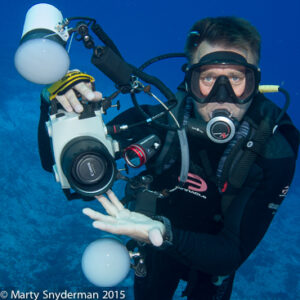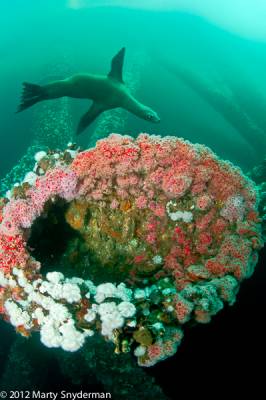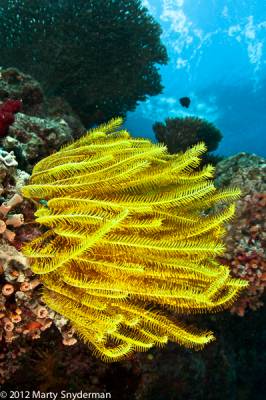
Here’s A Question For You
Let’s assume you want to create an image that has a strobe-lit, colorful foreground subject and properly exposed water in the background. If you are diving in rather dark, greenish water as you might be in New England, California, Oregon and Washington etc., would you want your strobe to emit a brighter light (more powerful strobe or higher power setting on your strobe) because the water at depth is not brightly lit by the sun, or would you want a less power, thus light that is not as bright, to be emitted from your strobe?
That is the scenario I experienced when I created this image while diving an oil rig in southern California.
As part-two of the same question, do you want a more powerful strobe or strobe setting in shallow, clear tropical water on a sunny day, or is the power of your strobe less important because the sun is providing a high level of ambient light at depth? That is the scenario I experienced when I created this photograph while diving over a very shallow reef in Fiji.
Take a moment to think about this. It’s not a trick question. But for many newer underwater shooters the answer seems counterintuitive.
The Answers With Some Explanation
When you create an image that has a subject in the foreground that you will be lighting with your strobe, and you want the water in the background of the shot to be properly exposed, you face the challenge of balancing the brightness of the light from your strobe with the brightness of the sunlit water in the background. It those two “brightnesses” are not the same you will experience one of the following problems. If the exposure of your strobe lit foreground subject is correct, your background will be too bright or too dark. Or, if the background exposure is correct and the water looks “right”, then your strobe lit foreground subject will be over or under exposed.
But the stated goal is to properly expose both your strobe lit, foreground subject and the water in the background as I was able to do in both of the photographs being used to illustrate this piece.
With balancing the exposures as your goal, in dark water you often need less power from your strobe, and in water that is brightly lit by the sun you will often need more power from your strobe. Here’s why: To properly expose relatively dark water in the background you will need a relatively wide open aperture, high ISO or slow shutter speed. All of those factors mean that a bright strobe used close to a subject is likely to “blow out”, or over expose, your foreground subject.
So with dark water in the background (oil rig shot) that you want to properly expose while shooting from relatively close to your foreground subject, you need to power down your strobe. And in bright water you will probably need to close down your aperture and use a low ISO to avoid over exposing the background water. With a closed down aperture and low ISO you are still asking your strobe to “paint in” the otherwise lost colors in your foreground subject. This means you need your strobe to emit a lot of light. So in shallow water in the tropics on sunny days you often end up needing your strobe to emit a lot of light so that you do not under expose your foreground subject.
If you aren’t quite sure you understand my explanation, don’t be too alarmed. This one can take a little effort and a few times through the reasoning process to “get it”.
Here’s some more input that might help you gain the desired insight: Imagine walking out of a dark room onto the street at night. While you were in the room the pupils in your eyes opened wide so you could see around the room. When you open the door and suddenly arrive in brightly lit surroundings it hurts your eyes. Your pupils need to close down. So in a dark room and in dark water the device that “sees” light needs to open wide. In bright lit, the same device needs to close down.
To keep going with the in-water part of this scenario, you also need your strobe to properly expose the foreground subject. So in dark water with your camera being set to allow more light in through a relatively wide aperture or being set to be more sensitive to light (higher ISO), you need to use a low power setting on your strobe so that you don’t over expose your subject. Conversely, in brightly lit water you often need to emit more light with your strobe because your camera system is set to let in less light or to be less sensitive to light.
I hope you find the information provided here to be helpful. And we hope to see you back again, in two weeks?. If you did benefit from this blog, please tell a friend about it.
Thank you,
Marty Snyderman For the Vivid-Pix Gang
We hope that you’ve learned how to Take Better Pictures.
Click Here to receive a Free Trial of Vivid-Pix software and Make Better Pictures: www.vivid-pix.com


